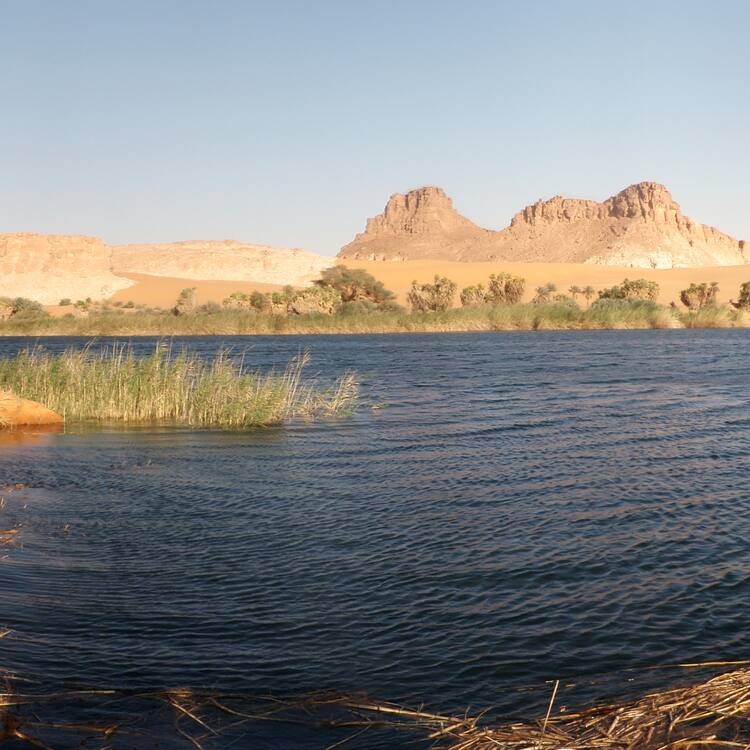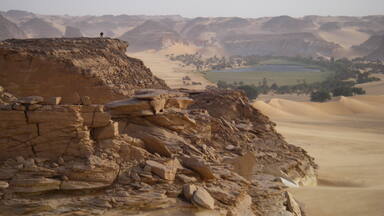Lakes of Ounianga
Lakes of Ounianga
The site includes eighteen interconnected lakes in the hyper arid Ennedi region of the Sahara desert covering an area of 62,808 ha. It constitutes an exceptional natural landscape of great beauty with striking colours and shapes. The saline, hyper saline and freshwater lakes are supplied by groundwater and are found in two groups 40 km apart. Ounianga Kebir comprises four lakes, the largest of which, Yoan, covers an area of 358 ha and is 27 m deep. Its highly saline waters only sustain algae and some microorganisms. The second group, Ounianga Serir, comprises fourteen lakes separated by sand dunes. Floating reeds cover almost half the surface of these lakes reducing evaporation. At 436 ha, Lake Teli has the largest surface area but is less than 10 m deep. With their high quality freshwater, some of these lakes are home to aquatic fauna, particularly fish.
Description is available under license CC-BY-SA IGO 3.0
Lacs d’Ounianga
Le site comprend 18 lacs interconnectés, situés dans le désert du Sahara, dans la région d’Ennedi. Il s’agit d’un large complexe de lacs (62 808 hectares) dans un environnement hyperaride et d’un paysage naturel exceptionnel qui doit sa beauté à la variété spectaculaire des formes et des couleurs. Les lacs – salé, hypersalé ou d’eau douce – sont alimentés par des eaux souterraines et se divisent en deux groupes, séparés par une quarantaine de kilomètres. Ounianga Kebir comprend quatre lacs dont le plus grand – le lac Yoan – s’étend sur 358 hectares avec une profondeur de 27 mètres. Ses eaux hypersalées ne recèlent que des algues et quelques micro-organismes. Le deuxième groupe, Ounianga Serir, comprend quatorze lacs séparés par des dunes de sable. Des roseaux flottants, qui couvrent presque la moitié de ces lacs, atténuent l’évaporation. Avec 436 hectares, le lac Teli est le plus vaste de ce groupe mais sa profondeur ne dépasse pas 10 mètres. Grâce à la bonne qualité de leurs eaux douces, certains de ces lacs abritent une faune aquatique, notamment des poissons.
Description is available under license CC-BY-SA IGO 3.0
Lagos de Unianga
Este sitio abarca 18 lagos conexos entre sí que se hallan en el desierto del Sahara, en la región de Enedi. El complejo lacustre abarca una superficie de 62.808 hectáreas y es el más vasto de los existentes en un medio geográfico de aridez extrema. El paisaje natural del sitio es de una belleza excepcional, debido a la asombrosa variedad de sus formas y colores. Los lagos –salobres, hipersalobres y de agua dulce– se alimentan de aguas subterráneas y forman dos conjuntos que distan 40 kilómetros entre sí. El primer conjunto es el de Unianga Kebir, que cuenta con cuatro lagos. El más grande de ellos –el Lago Yoan– tiene 358 hectáreas de superficie y 27 metros de profundidad. En sus aguas, extremadamente salobres, solamente viven algas y algunos microorganismos. El segundo conjunto lacustre, denominado Unianga Serir, consta de 14 lagos separados entre sí por dunas. Casi la mitad de su superficie está cubierta por juncos flotantes que atenúan la evaporación de sus aguas. El lago más vasto de este último conjunto es el Lago Telli, que tiene una superficie de 436 hectáreas, pero tan sólo 10 metros de profundidad. Gracias a la excelente calidad de su agua dulce, algunos de estos lagos albergan una fauna acuática, compuesta sobre todo por peces.
source: UNESCO/CPE
Description is available under license CC-BY-SA IGO 3.0
ウニアンガ湖沼群
年間降水量が2mm以下の砂漠地帯であるチャド北東部にあるウニアンガ湖沼群は、2ヵ所に分かれて存在する18個の湖からなる。現在は各湖の大きさや深さ、色、化学組成などは多様だが、約1万年前は一つの大きな湖だった。そのため、世界的にも珍しい水利体系を持つとされ、砂漠にもかかわらず恒久的な湖が維持されている。湖と、ヤシなどの植生、砂漠によるさまざまな色彩が作り出す美しい自然景観が際立ち、湖の形と分布に加え、風によって水面を流れていくアシなどが「砂漠の中を流れる水波」の印象を与えている。source: NFUAJ
Meren van Ounianga
Het merengebied van Ounianga bestaat uit achttien onderling verbonden meren in de extreem droge Ennedi regio van de Sahara en omvat 62.808 hectare. Het is een bijzonder mooi natuurlijk landschap met opvallende kleuren en vormen. De zoute, hyperzoute en zoetwatermeren worden gevoed door grondwater en zijn verdeeld in twee groepen die 40 kilometer van elkaar liggen. Ounianga Kebir bestaat uit vier hyperzoute meren, waarvan Yoan de grootste is met een oppervlakte van 358 hectare en 27 meter diepte. Ounianga Serir bestaat uit veertien meren, gescheiden door zandduinen. Het zoetwatermeer Lake Teli heeft de grootste oppervlakte (436 hectare), maar is minder dan 10 meter diep.
Source: unesco.nl
Outstanding Universal Value
Brief synthesis
Located in North-Eastern Chad, in a hot and hyperarid desert setting with less than 2mm rainfall per year, the Lakes of Ounianga comprises a total of 18 lakes, in two groups, displaying a variety of sizes, depths, colorations and chemical compositions. The property covers 62,808 ha and has a 4,869 ha buffer zone. The Lakes of Ounianga property is located in a basin which, less than 10,000 years ago, was occupied by a much larger lake and has a globally unique hydrological system, sustaining the largest permanent freshwater lakes system in the heart of a hyperarid environment.
The property also displays a range of striking aesthetic features, with varied coloration associated with the different lakes and their vegetation, and the presence of dramatic natural desert landforms that all contribute to the exceptional natural beauty of the landscape of the property. The shape and distribution of the lakes, combined with the effect of the wind moving the floating vegetation in the lakes, gives the impression of “waves of water flowing in the desert”.
Criterion (vii): The property represents an exceptional example of permanent lakes in a desert setting, a remarkable natural phenomenon which results from an aquifer and associated complex hydrological system which is still to be fully understood. The aesthetic beauty of the site results from a landscape mosaic which includes the varied coloured lakes with their blue, green and /or reddish waters, in reflection of their chemical composition, surrounded by palms, dunes and spectacular sandstone landforms, all of it in the heart of a desert that stretches over thousands of kilometres. In addition, about one third of the surface of the Ounianga Serir Lakes is covered with floating reed carpets whose intense green colour contrasts with the blue open waters. Rock exposures which dominate the site offer a breathtaking view on all the lakes, of which the colours contrast with the brown sand dunes separated by bare rock structures. The shape and distribution of the lakes, combined with the effect of the wind moving the floating vegetation in the lakes, gives the impression of “waves of water flowing in the desert”.
Integrity
The boundaries of the 62,808 ha property have been designed to ensure its integrity. The property includes the area situated below the 450m contour line within the immediate lake watershed. The 4,869 ha buffer zone includes the village of Ounianga Kebir beside Lake Yoan. Zoning for management of the site takes into account pressures which are now mainly concentrated on Lake Yoan. Ounianga Serir, the smallest village (population of c. 1,000 in 2012) is next to the lake Teli, inside the property.
The hydrological system of the Lakes of Ounianga is functioning and the water level is stable apart from a slight seasonal variation, thanks to a groundwater supply which compensates evaporation losses.
The beauty and aesthetic values of the property have been well conserved. Although a good number of people live around lakes Yoan and Teli, local initiatives are assuring the compatibility between human activities and conservation of the site’s values. Activities planned in the management plan strengthen and complement these initiatives. In addition the recently adopted Decree No. 095 which aims to maintain traditional agricultural practices in the property instead of intensive agriculture will enhance the conservation of the property.
Protection and management requirements
Decree n° 1077/PR/PM/MCJS/2010 of 15.12.2010 designated the Lakes of Ounianga as a “Natural site”; the protected area system of Chad, as established in Law n°14/PR/2008, focuses on fauna and flora conservation and, alone, is not fully suited to Ounianga; thus, responsibility for the property is vested in the Ministry of Culture. There is high level political support for the protection and management of the property at national and local levels.
Under the decree, all activities that could threaten the integrity of the property, including mining, are forbidden. The national designation is similar to IUCN Category III for protected areas. This decree is complemented by the Decree No. 630 which regulates the need to prepare Environmental Impact Assessments for development projects.
The property has an effective management plan in place for the short and long term, and there are adequate resources and staffing provided its implementation and monitoring.
Wetlands such as the Lakes of Ounianga are also protected by Law 14/PR/98. An action plan is implemented through local associations to avoid negative impacts on the site. Conservation efforts focus on factors that could impact the site’s integrity, which include effective measures to regulate urban development, address litter and waste management, support sustainable agriculture and ensure that traffic, tourism and other uses is maintained at levels that do not impact the Outstanding Universal Value of the property. Several local associations created at the initiative of the local governmental authorities and the local communities are also responsible for the conservation of the property. These activities are implemented with the support of a Local Management Committee, which provides input for improving the existing management plan.



